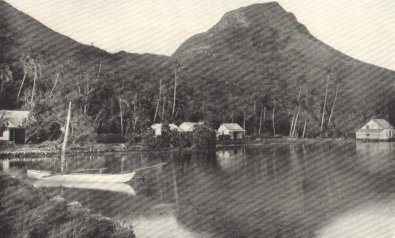Tahiti
|
|
Tahiti is the largest island in French Polynesia, located in the archipelago of Society Islands in the southern Pacific Ocean, at Template:Coor dm. The island had a population of 169,674 inhabitants at the 2002 census. (This makes it the most populated island of French Polynesia, holding 69% of the total population.) The capital is Papeete, on the northwest coast. Tahiti has also been historically known as Otaheite.
Tahiti is some 28 miles (45 km) long at the widest point and covers 1,048 km² (404 sq. miles), with the highest elevation being at 2,241 meters (7,352 feet) above sea level (Mount Orohena).The island consists of two roughly round portions centered on volcanic mountains, connected by a short isthmus named after the small town of Taravao, which sits there. The northwestern part is known as Tahiti Nui, or big Tahiti, and the southeastern part, much smaller, is known as Tahiti Iti (small Tahiti) or Taiarapu. Whereas Tahiti Nui is quite heavily populated (especially around Papeete) and benefits from rather good infrastructure, such as roads and highways, Tahiti Iti has remained quite isolated, its southeastern half (Te Pari) being accessible only by boat or hiking.
The vegetation is lush rain forest. The wet season is November through April.
The island is served by Faaa International Airport.
| Contents |
History
The native population is Polynesian, and is estimated to have settled on the island sometime between 300 and 800 AD, although some estimates place the date earlier.
The fertile island soil combined with fishing provided ample food for the population with ease. The perceived relaxed and contented nature of the local people and the characterization of the island as a paradise much impressed early European visitors, planting the seed for a romanticization by the West that endures to this day.
Although the islands were first spotted by a Spanish ship in 1606, Spain made no effort to trade with or colonize the island. Samuel Wallis, an English sea captain, sighted Tahiti on June 18, 1767 and is considered the first European discoverer of the island.
Wallis was followed in April 1768 by the French explorer Louis-Antoine de Bougainville who was completing the first French circumnavigation. Bougainville made Tahiti famous in Europe when he published the account of his travel in Voyage autour du Monde. He described the island as an earthly paradise where men and women live happily in innocence, away from the corruption of civilization. His account of the island powerfully illustrated the concept of the noble savage, and influenced the utopian thoughts of philosophers such as Jean-Jacques Rousseau before the advent of the French Revolution.
In 1774 Captain James Cook visited the island, and estimated the population at that time to be some 200,000. This was probably too high; another estimate from the same period was 121,500.
After Cook's visit, European ships landed on the island with ever greater frequency. The best-known of these ships was the HMS Bounty, whose crew mutinied shortly after leaving Tahiti in 1789. The European influence caused significant disruption to the traditional society, by bringing Christianity, prostitution, venereal diseases, and alcohol to the island. Introduced diseases including typhus and smallpox killed so many Tahitians that by 1797, the island's population was only about 16,000. Later it was to drop as low as 6,000.
In 1842 the kingdom of Tahiti was declared a French protectorate.
In 1880, King Pomare V (1842–1891) ceded sovereignty to France.
In 2004, Tahiti and the whole French Polynesia, become a Territoire d'outre-mer (French overseas territory).
French painter Paul Gauguin lived on Tahiti in the 1890s and painted many Tahitian subjects. Papeari has a small Gauguin museum.
Modern Tahiti
Tahitians are French citizens with full civil and political rights. The Tahitian language and the French language are both in use.
Tahiti hosts a French university: the University of French Polynesia (Universite de la polynesie francaise)[1] (http://www.upf.pf). It is a small university. It counts around 2,000 students and about 60 researchers. Physicists Pascal Ortega [2] (http://www.upf.pf/~ortega) (lightning studies) and Alessio Guarino [3] (http://www.upf.pf/~guarino) (nonlinear physics) are among them. In the Human Sciences departement sogiologist L. Schuft deserves to be mentioned for her study on the integration of mainlander French workers in Tahiti.
Tourism is a significant industry, especially during the Heiva festival in Pape'ete celebrating indigenous culture and the commemoration of the storming of the Bastille in France, both of which take place annually in the month of July.
Photographs

View of Raiatea Mountain. The mummies of Tahitian rulers were formerly deposited on this mountain, traditionally considered holy.
Missing image
FautauaFalls.jpg
Image:FautauaFalls.jpg
Vista with Fautaua Fall, a waterfall some 600 feet (183 m) high.
Above two photos by L. Gauthier from October 1920 National Geographic Magazine
See also
External links
- About Tahiti on tahitinuitravel.com, with island map (http://www.tahitinuitravel.com/about/Tahiti/default.asp)
- Map of French Polynesia (http://www.mapsouthpacific.com/tahiti/index.html)
- Finding French Polynesia (http://www.southpacific.org/text/finding_tahiti.html)
- CIA Factbook entry (http://www.cia.gov/cia/publications/factbook/geos/fp.html)
- Picture gallery (http://www.linda.ch/tahiti/)da:Tahiti
de:Tahiti es:Tahití fr:Tahiti he:טהיטי nl:Tahiti pl:Tahiti pt:Taiti zh:大溪地

